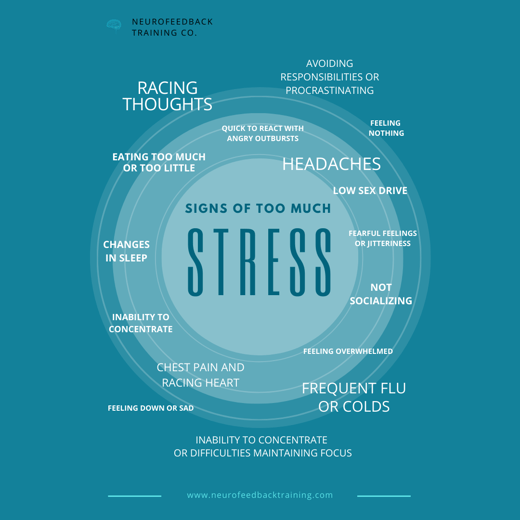What are the best brain Exercises for kids?
Many parents are looking for ways to improve their childrens' school and athletic performance and "brain training" is the latest fad, (and one that has merit if the tools actually train the brain). Often parents are looking to add tools but what they don't know is that sometimes it's not a matter of removing what interferes with performance.
What's bad for improving school performance?
 Stress
Stress
in kids this includes periods of worrying, and asking questions about bad outcomes. Sometimes kids will not sleep well or loss interest in eating--possible signs that a child's brain is trying to problem-solving with the stress response, not what we want if we're trying to improve school performance! We want them to learn from a place of calm, being able to focus on work and to sleep well and wake up rested. (For more read Boulder Neurofeedback trainer, Joy Om's, comments on the stress response).
Stress-response in parents
If mom or dad operate in the above mode, that too, can signal to the child that they need to be in stress response mode. Childrens' nervous systems align themselves with their parents' like all pack animals! If mom or dad are stressed, the child can feel that energy. Read more
Lack of proper nutrition
Nutrition expert Dr. Mark Hyman: "Four out of ten kids are now overweight and one in seven kids has attention issues, often caused by a high-sugar, nutrient-poor diet." You will help the brain perform much better by cutting down on the family's sugar intake, and that includes white foods--breads, rice, pasta.
Does Brain Training work for kids?
Great brain training practices
 1. Neurofeedback.
1. Neurofeedback.
Unlike devices that add micro-currents or ones that say they are "brain training" but really are games, neurofeedback is actually teaching your brain learn more effectively. Kids respond well to neurofeedback and the results often last far beyond the training period. See below for a more detailed explanation how neurofeedback works.
2. Sleep More.
Children need 10-13 hours of sleep per night, on the higher end when they are toddlers. Studies now show that during sleep the brain rids itself of the day's metabolic toxins, which is essential for brain health.
 3. Eat Foods for Studying.
3. Eat Foods for Studying.
Did you know that 60 percent of your brain is made up of DHA – an omega-3 fat that you get from algae and fish? Salmon, eggs rich in omega-3s, probiotics, and seaweed snacks are great for the brain!
4. Exercise That is Fun.
It increases oxygen flow to the brain, and the healthy production of neurotransmitters essential for cognitive and emotional well-being. Research has shown that exercise is linked with higher grades and over a lifetime, increases fitness of the brain areas essential for memory and cognitive functioning.
Related:
Is Neurofeedback Effective and How Does NeurOptimal® Neurofeedback Work?
 When the brain is about to change states and perform an action it produces an electrical “dance” called turbulence. The neurofeedback system identifies the turbulence and through immediately stopping the music/audio in that millisecond the brain’s orienting response is triggered. The orienting response is the process every brain uses to assess changes in their environment. The brain uses auditory changes as it’s primary way to sense change because we can hear 360, as opposed to visual which is limited to 180 degrees of perception.
When the brain is about to change states and perform an action it produces an electrical “dance” called turbulence. The neurofeedback system identifies the turbulence and through immediately stopping the music/audio in that millisecond the brain’s orienting response is triggered. The orienting response is the process every brain uses to assess changes in their environment. The brain uses auditory changes as it’s primary way to sense change because we can hear 360, as opposed to visual which is limited to 180 degrees of perception.
The orienting response is the brain’s automatic response of ‘coming into the present’ in a similar way as to when you are lost in a daydream and someone calls your name, you automatically orient yourself in the present. This response is triggered when the music stops. It automatically comes in the present and identifies what the needs are for the here-and-now as well as “sees” what it’s about to do automatically. If it identifies an activity that it is about to perform that is not in alignment with present needs it will automatically adjust it’s activity.
For example, if the brain is alerted to come into the present and it ‘sees’ that it is in a safe environment and is reading a book, and it sees it is about to perform a stress response, such as to scan the environment (hypervigilence), it will immediately change it’s functioning to allow for a sustained focus.
The brain is designed to optimize it’s functioning. The neurofeedback system allows for the brain to see it’s own maladaptive habits and change them as it sees fit. There is no outside variable forcing change.
The neurofeedback system is like a mirror and each central nervous system (CNS) changes itself to optimize its own functioning, whether it be an ability to focus when needed, go into sleep mode at night, be calm when there’s no danger, etc. View our guide here on what to expect in a neurofeedback session or watch our neurofeedback webinars.
Watch Related Webinar
Where Can I Find Neurofeedback Near Me?
How to Get Started
Can't find a neurofeedback provider near you? Consider renting a professional-grade neurofeedback equipment for home use. The rental is the exact same system used for the in-office sessions (NeurOptimal 3). The device is easy to set up and we provide all the materials you need to do the brain training sessions at home. Read our renting guide to learn the cost and how to get started.